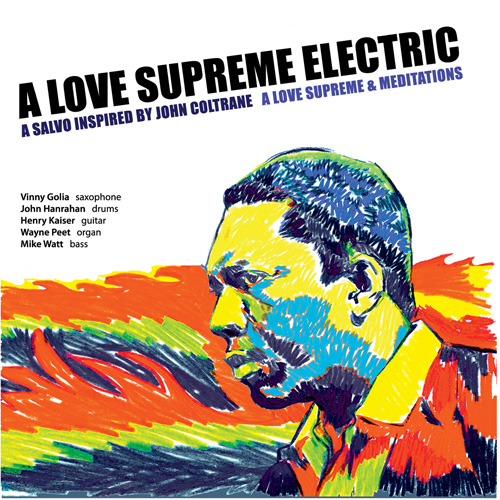In fact, ALSE asks “What if?” over and over again, joyously interrogating the twin templates of Coltrane’s A Love Supreme and Meditations from a kaleidoscopic array of angles. All five performers weigh in with their solo perspective, but the magic is that the listener is invited to contribute, too. After hearing this music, you may never hear Coltrane in the same way again.
Kaiser, the project’s de facto theorist, chose to start with “What if A Love Supreme and Meditations are two parts of one single expression of an ecstatic spiritual state?”
“I had known that Coltrane intended his Meditations suite to be a spiritual sequel to his A Love Supreme suite,” Kaiser writes in his liner notes for A Love Supreme Electric, notes that are as provocative as the music itself. “Thus it was natural to suggest that with our A Love Supreme Electric gigs, we often play Meditations as the second set. After having done this more than a few times, I would note that….the two suites really do fit together to actually be one 2-part suite, where all the individual sections inform, deepen, cross-reference, and expand on one another, in both the musical and spiritual domains.
“The 2-CD set that we present to you here,” he continues, “is this current crew’s fiery salvo of our testimony to this.”
The band’s recognition of the essential unity of Coltrane’s two masterpieces is profound, as is the ease with which saxophonist Golia, percussionist Hanrahan, guitarist Kaiser, keyboardist Peet, and bassist Watt answer another big “what if?”: “What if Coltrane had survived cancer—which took him at the untimely age of 40, in 1967—and joined his occasional colleague Miles Davis in pioneering electric jazz?”
There’s no way of knowing whether this is where the saxophonist would have gone, although his string of 1961 gigs with Wes Montgomery suggest that he was not immune to the sonic possibilities of the electric guitar. Viewed with an open mind, however, Coltrane would seem a likely candidate to go electric. His late-career interstellar explorations have, conceptually if not sonically, more to do with the psychedelic ethos than any of Davis’s acoustic recordings, and while there are persistent rumours of Davis and Jimi Hendrix wanting to record together, the saxophonist’s loquacious voice would have been as apt for that project than Davis’s terse trumpet.
In his notes, Kaiser speaks about discovering a surprising sonic kinship between Coltrane and Davis, a realization sparked by his earlier investigation of the latter’s late ’60s and early ’70s music in his band with trumpeter Wadada Leo Smith, Yo Miles!. “I was surprised to note that there were many below-the-surface features that were common with Coltrane’s meditations suite and the way that Miles’ electric music functioned,” he writes. “Independent systems happening simultaneously, tiny seeds growing into giant beanstalks of music growing beyond the sky, and a vision beyond where jazz had been before.”
The A Love Supreme Electric quintet references those qualities to create a sound that is simultaneously of the present, of the past, and of the might-have-been. While sounding exactly like himself—that is, a highly individualistic musician whose stylistic touchstones include Eric Dolphy and Roscoe Mitchell as well as Coltrane—Golia’s big tenor sound provides a link to acoustic jazz even in the midst of the band’s most futuristic interplay. And, speaking of melding the past and the future, check out Kaiser’s squealing slide invocation of Sonny Sharrock early on in Meditations; that the pioneering noise guitarist and Coltrane never got to perform together is one of the many tragedies of the saxophonist’s untimely death—and another “what if?” to contemplate.
There are more of those questions here. What if Coltrane, who was known for his close study of North Indian music, extended his reach to encompass the shamanistic sounds of Korea? (And, for that matter, what if he had allowed his spiritual curiosity to veer more completely from ecstatic Christianity towards shamanic thinking?) What if psychedelic rock music hadn’t been dumbed down by corporate interests and self-indulgent performers, but had been allowed to flourish? What if, as Kaiser suggests, Meditations and A Love Supreme’s cyclical structures function as a kind of sonic Ouija board, allowing inductive trance technologies to unite seemingly disparate performers?
Close the door, unplug the phone, and press “play”. You’ve got an hour, 47 minutes, and 41 seconds to think.
A Love Supreme and Meditations press release

